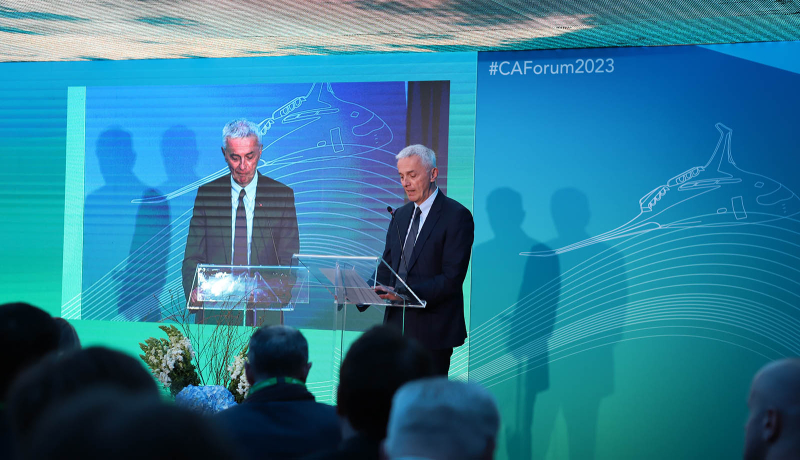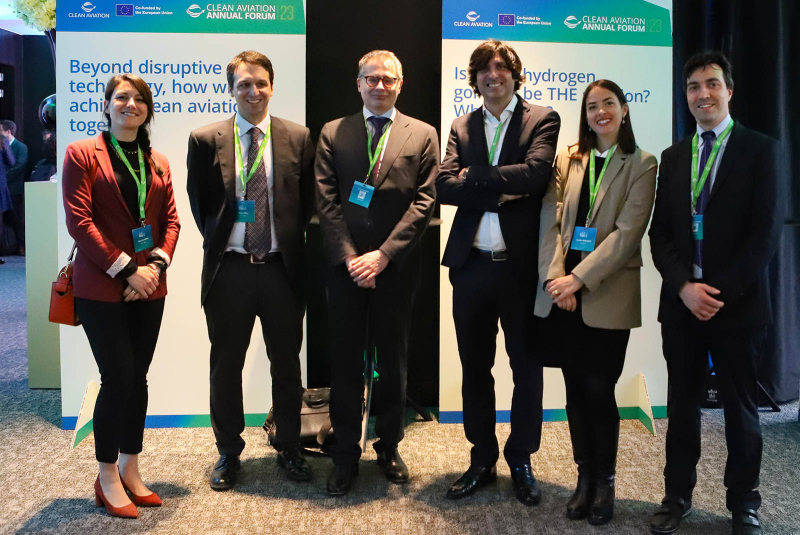Future
The Annual Forum is back
The two-day Clean Aviation Annual Forum joined the global chorus demanding an acceleration toward climate neutrality, focusing on what has been done and what yet needs to be done for aviation.
Mar 2023
There is no time to waste. The latest report of the IPCC(the Intergovernmental Panel on Climate Change that is part of the UN) leaves no room for interpretation or sugarcoating. Climate change now produces impacts already evident on more than 3 billion people and it is necessary to speed-up adaptation and mitigation measures to keep the global temperature’s increase within 1.5° Celsius.
Europe has urgently and very attentively welcomed this latest report - the next one will be issued as scheduled by 2030, when the desired effects of the Fit for 55 plan should be tangible, aiming to cut CO2 emissions in half - and urged national governments as well as every economic sector.
Just three days after the release of the IPCC report, the aviation sector – which accounts for about 2.5 percent of global carbon emissions - gathered in Brussels for the return of the Clean Aviation Annual Forum. More than 200 people (with hundreds more online, for a total of 1150 attendees) sat in the conference hall on whose stage were "the most capable and experienced representatives of aviation,” as Axel Krein, Clean Aviation's Executive Director, put it in his opening speech. "The clock is ticking, and European aviation must continue to lead the way.”
"The clock is ticking, and European aviation must continue to lead the way"
Krein was quick to cite the IPCC report because of how it intersects with the EU Green Deal and to point out that the research and innovation program he heads has been committed to climate neutrality and more sustainable air transport since Clean Sky was first launched in 2007. Through Clean Sky 2, and with the advent of Clean Aviation last fall, the goal is now to leverage the achievements of previous technology development and demonstration projects to hit the first common targets on the horizon: -30% in short to medium-haul routes and -50% in regional routes (compared to 2020 state-of-the-art aircraft) by 2030.
Indeed, the European Commission's public-private partnership has made available a budget of more than € four billion for the new projects announced a few months ago. During the forum, Krein reiterated how expectation is at the level of the momentous challenges we all face, if it is true (as it is) that everyone must do their part for sustainability.
Today, I see policymakers, aircraft and aircraft engine makers, industry supply chain leaders and researchers in front of me, united in their efforts to accelerate top level new technology development, new regulations, and government action,” Krein said. "I am also gratified to see numerous representatives from airlines, airports, energy and fuel producers joining our network to present solutions for climate neutral aviation.”
Clean Aviation's new course is based on the so-called three thrusts: these will develop enabling technologies, leverage essential knowledge and capabilities, and de-risk the maturation and validation of such technologies and solutions to maximize their impact. To accomplish this, it focuses on research and development areas across the thrusts: aircraft configuration and technology integration, new certification methods and regulatory means.
However, all of this needs political support, new rules and streamlining of procedures. The fact that we need bureaucratic speed and simplification for strategies and business plans was the mantra reiterated from the Forum stage. This was also reiterated by Henrik Hololei, Director-General for Mobility and Transport at the European Commission. "Aviation needs to continue to set an example of foresight and preparedness toward transportation sustainability challenges”, Hololei said in his address to the Forum. "For example, we need to increase the production of SAF (sustainable alternative fuels, ed.) and we want to do that by 2025.”
What Clean Aviation wants to achieve is a generational leap in aviation technologies, considering the enormous complexity of the challenges, the variety of disciplines and solutions, and the limited time available. It is also necessary to quickly move forward when it comes to innovation and, together, optimize the solutions currently available, industrial time and processes, and take advantage of digital tools and circularity. And in particular, investing in talent, because there is no better time for this.
"We will need the seamless support from european policymakers to allow these resources toward EU to continue"
The call for new, engaged engineers, scientists and researchers was also to Avio Aero CEO Riccardo Procacci's speech. Invited to speak along with the CEO of Universal Hydrogen, the CEO of Widerøe Zero and the Group Markets Director of EasyJet, on the Forum's first panel - entitled "Fuelling the future of flight: Electric, E-fuels or Hydrogen” - Procacci first recalled the value of the partnership with Clean Aviation that has lasted since about 2006 (and includes crucial technology achievements and demonstrations) and then joined the call to continue in this direction toward ground and airborne demonstrations of the hybrid-electric and hydrogen propulsion solutions the company is working hard on.
"We strongly believe in, and love, what we do,” Procacci said. "With our parent company GE Aerospace, we have invested more than $1.9 billion in R&D, and programs like Clean Aviation with the presence of partners like Airbus and Safran - with whom we collaborate rather than compete in this case - enable significant investment in Europe, that is beneficial for the entire aviation sector. But we will need the seamless support from European policymakers to allow the resources towards EU to continue. At the same time, new technologies alone cannot meet short-term objectives of emissions reduction, and therefore SAFs are essential, I would say inevitable, for the transition.”
Sustainable fuels were also brought up by EasyJet's Group Markets Director, Thomas Haagensen, as part of a roadmap toward reducing emissions for the European airline, which has a fleet of more than 300 single-aisle aircraft, all powered by CFM International* engines (CFM56 and LEAP). In this case, LEAP engines for airlines generated an average of 19% improvement in fuel consumption over the conventional CFM56s.
"The expectation is to see hydrogen implemented first on smaller aircraft, then on regional ones, to power fuel cells in hybrid electric architectures"
Hydrogen was the focus of the second day at the Forum - along with medium- to short-range hybrid electric aircraft configurations and new certification processes - especially during the panel discussion on "Propulsion Efficiency and Hydrogen-Powered Aircraft" in which Luca Bedon, R&T Leader of Avio Aero, spoke alongside Alan Newby, Director of Technologies and Future Programmes at Rolls-Royce, and Tine Tomažič, R&D Director of Pipistrel – a subsidiary of Textron Aviation specialized in electrification of flight.
Bedon emphasized the need to look at all solutions in technology development and demonstration work simultaneously, and to look at every segment of air transport (from small jets to large aircraft for intercontinental flights). "SAFs seem like a possible answer in all segments and are already available. However, we need to consider the availability and competition there will be with the automotive market, at least for some biofuels, so we need to envision the future adoption of SAFs only for applications that will not be able to take advantage of electrification and direct use of hydrogen,” Bedon said.
In a later passage, Bedon outlined what the course of adoption of these new propulsion technologies might be, in close dependence on the level of maturity they will reach. "The expectation is to see hydrogen implemented first on smaller aircraft, then on regional ones, to power fuel cells in hybrid electric architectures. Hydrogen combustion, on the other hand, will require technological maturation and could potentially become the fuel for short- and medium-haul aircraft, which today account for 80% of daily flights and are responsible for two thirds of total emissions.”
Thus, Bedon reviewed the three projects of Clean Aviation in which Avio Aero is putting forth all its efforts together with partners at every level. The two he coordinates directly are AMBER, a hybrid-electric system developed around the new Catalyst engine, and HYDEA, which will use a GE’s Passport engine by redesigning the cryogenic fuel system along with the components involved in combustion to then test a demonstrator on the ground in the first phase and then in flight on the A380. Finally, there is Ofelia, devoted to the propulsive efficiency of an open-fan architecture with an advanced turbine system that will provide a 20% reduction in fuel consumption and an enlarged radius, through CFM's RISE demonstrator.
On the sidelines of the forum, we interviewed Axel Krein, Riccardo Procacci, Luca Bedon, and the and the Head of Programmes at Clean Aviation, Sébastien Dubois, for a summary that is available in this video report.

*CFM International, a 50/50 joint company between GE and Safran Aircraft Engines









